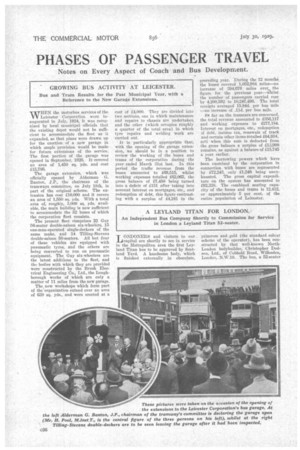PHASES OF PASSENGER TRAVEL
Page 58

If you've noticed an error in this article please click here to report it so we can fix it.
Notes on Every Aspect of Coach and Bus Development.
GROWING BUS ACTIVITY AT LEICESTER.
Bus and Tram Results for the Past Municipal Year, with a Reference to the New Garage Extensions.
WHEN the motorbus services of the Leicester Corporation were inaugurated in July, 1924, it was recog,nized by local municipal officials that the existing depot would not be suffident to accommodate the fleet as it expanded, so that plans were drawn up for the erection of a new garage in which ample provision would be made for future extensions of the service. The first portion of the garage was opened in September, 1926. It covered an area of 1,450 sq. yds. and cost £15,786.
The garage extension, which was officially opened by Alderman G. Banton, J.P., the chairman of the tramways committee, on July 18th, is part of the original scheme. The extension has cost £10,000 and it covers an area of 1,550 sq. yds. With a total area of, roughly, 2,000 sq. yds. available, the main building is now sufficient to accommodate the 52 buses of which the corporation fleet consists.
The present fleet cbmprises 23 Guy r6-seater double-saloon six-wheelers, 15 one-man-operated single-deckers of the same make, and 14 Tilling-Stevens double-saloon 50-seaters. All but four of these vehicles are equipped with pneumatic tyres, and the others are being converted to run on pneumatic equipment. The Guy six-wheelers are the latest additions to the fleet, and the bodies with which they are provided were constructed by the Brush Electrical Engineering Co., Ltd., the Loughborough works of which are only a matter of 11 miles from the new garage.
The new workshops which form part of the 'organization extend over an area of 630 sq. yds., and were erected at a cost of £4,000. They are divided into two sections, one in which maintenance and repairs to chassis are undertaken and the other (which occupies roughly a quarter of the total area) in which tyre repairs and welding work are carried out.
It is particularly appropriate that, with the opening of the garage extension, we should be in a position to review the working of the buses and trams of the corporation during the year ended March 31st last. In this period the traffic revenue from the buses amounted to £69,515, whilst. working expenses totalled £62,065, the gross balance of £7,450 being turned into a deficit of £151 after taking into account interest on mortgages, etc., and redemption of debt, this figure contrasting with a surplus of £4,241 in the preceding year. During the 12 menths. the buses covered 1,052,984 miles—an increase of 394,679 miles over the figure for the previous year—v7hilst the number of passengers carried rose by 4,200,592 to 10,247,496. The total receipts averaged 15.84d. per bus mile —an increase of .11d. per bus mile.
Se, far as the tramcars are concerned, the total revenue amounted to £356,117 and working expenses to £277,184. Interest on mortgages, etc., redemption A debt, income tax, renewals of track and certain Other items totalled £64,934,. rued when this sum is deducted from the gross balance a surplus of £13,999 remains, as against a balance of £15,745 a year earlier.
The borrowing powers which have been exercised by the corporation in connection with buses are represented by £72,243, only £1,249 being unexhausted. The gross capital expenditure on the system has amounted to £92,338. The combined seating capacity of the buses and trams is 12,412, or approximately 5 per cent, of the entire population of Leicester.












































































































